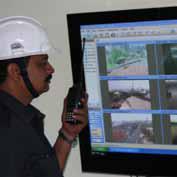Mission
With the International Ship & Port Security (ISPS) code coming into effect, the port authorities of the Vizag Seaport terminal recognized the need to step up security and keep a vigilant eye on the waters and nearby ships.
Additionally, with the implementation of International Ship & Port Security (ISPS) code, the port required an advanced surveillance mechanism to help secure the perimeter, water fronts and entry and exit points of the port. Overall, increasing operational alertness was also a key objective of port authorities.
Solution
The Vizag Seaport, which had a completely manual security system with guards patrolling the port, decided to go in for a greenfield IP-based surveillance solution.
In the first phase, the port installed 17 cameras to monitor the cargo handling operations and allied activities at the Vizag Seaport.
The implementation team had to take utmost care while installing the system at all critical locations due to the nature of the weather and applications sensitivity and also to ensure future-friendly installation and minimal damage to the environment.
Result
The implementation of Axis network-based surveillance system delivers the benefits of enhanced monitoring and operational alertness, enabling authorities to supervise port activities on a 24/7 basis with minimal manual intervention.
Additionally, the recorded data also serves as a powerful training tool to help new employees understand port functioning.
The Vizag Seaport terminal is part of Visakhapatnam Port, which is one of the 12 major ports in India. The terminal was part of an expansion project under PPP (Public Private Partnership) scheme of Government of India. The port carries out bulk handling of cargo on a 24/7 basis, with 25 vessels on average visiting the terminal per month.
Vizag Seaport Terminal as a part of Visakhapatnam Port and with the International Ship & Port Security (ISPS) code coming into effect, the port authorities were looking for a way to enhance their monitoring and surveillance capabilities. While upgrading security was an important objective, the authorities were also keen on improving operational alertness. The existing manual security system with guards patrolling the port had a number of limitations. For example, senior executives could not get a real-time picture of the port activities unless they were present on site.
In the first phase, the team installed a total of 17 cameras, including AXIS 215 PTZ-E and AXIS P1343 cameras that are suitable for outdoor locations. AXIS 233D and AXIS Q6032-E PTZ Network Cameras, which are ideal for seaports and harbours, were also used. These cameras were stationed at all the entry and exit points - vehicular, railway and the sea front - thus covering the perimeter effectively. Additionally, cameras were also placed to cover all the roads, stockyards, machine control rooms, switchyard and weighbridges, thus monitoring all the commercial waypoints in the terminal.
The cameras also covered all the floors of the administrative office, staff canteens, reception, waiting room, conference rooms for staff and establishment security.
Finally, some cameras were implemented on the cranes engine room and back up room with a view to meet training and monitoring needs. The factors that were given the highest priority during planning and implementation were environment, usage demand and the ruggedness to withstand all these elements. The implementation has brought a number of benefits.
Increased operational alertness
 |
| Axis network surveillance in use at Vizag Seaport |
It has also reduced a lot of unnecessary disputes with the contractors and sub-contractors and with the external entities that work at the terminal. In addition, the surveillance system acts as a deterrent for any possible thefts or security and protocol violation. This results in an increased sense of security for the employees at the port.
Additionally, the solution allows for effective monitoring of fugitive dust emissions and also enhances pollution control methods.
Reducing manual intervention
The installation has led to considerable reduction of manpower required. With 24/7 surveillance in place, most of the top level management has eyes and ears to all the locations without moving out of their offices. This enables the management to take real time decisions without having to be present in person at the terminal.
The management can also check on staff and third party entities at the terminal at any given time. The surveillance solution also facilitates random remote inspection of the port by share holders spread over three different countries.
Training
Apart from better surveillance, the system provides data that can serve as a training tool for new employees. For example, existing videos of key events can be used to educate new employees on the procedures for handling such events. New employees can also learn how to react on emergency events and how to contain them.












